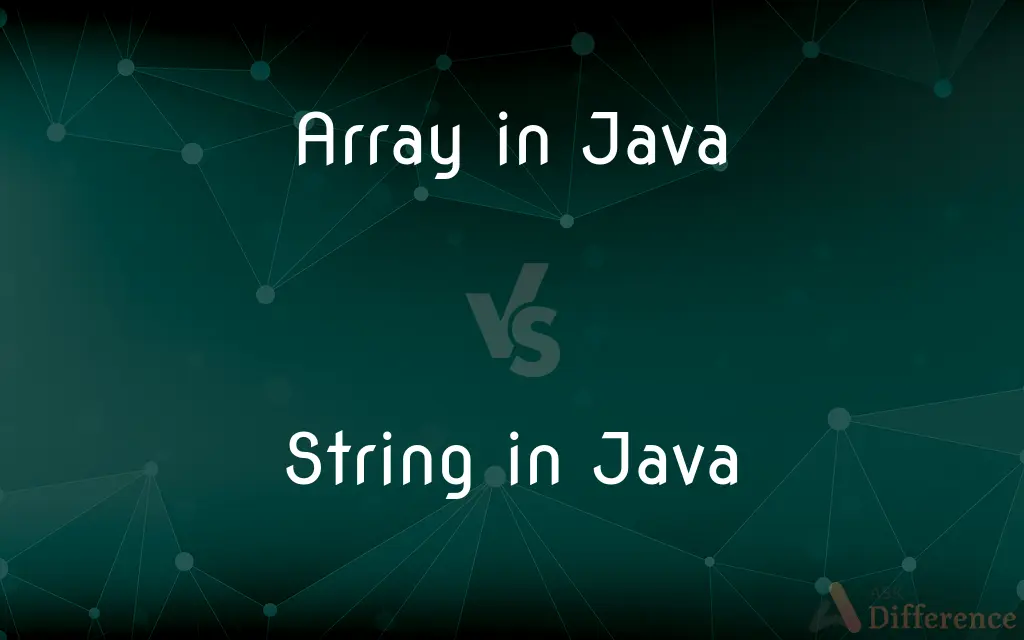Array in Java vs. String in Java — What's the Difference?
By Tayyaba Rehman — Published on January 12, 2024
An Array in Java is a fixed-size collection of elements of the same type, while a String in Java is a sequence of characters and an object of the class String.

Difference Between Array in Java and String in Java
Table of Contents
ADVERTISEMENT
Key Differences
An Array in Java is a data structure that can hold multiple values of the same type at contiguous memory locations. Each element in an array is accessed by its index, with indexing starting from zero. On the other hand, a String in Java is a sequence of characters treated as an object of the class String. Strings are immutable in Java, meaning once a String object is created, its value cannot be changed.
Arrays in Java can store primitives like int, char, as well as objects of a class depending on the declared type. The length of an array is fixed after its creation and cannot be altered. Strings, in contrast, are backed by a char array, but this implementation detail is encapsulated within the String class, and the char array cannot be directly accessed or modified.
Java arrays are versatile; they can be single-dimensional or multi-dimensional. Arrays have no methods of their own as they are considered to be a low-level construct. Strings have various methods for manipulation and inspection, such as length(), charAt(), substring(), and many more, which make them a higher-level construct with more functionality.
Memory-wise, an array’s size needs to be known at the time of its creation and remains constant thereafter. Strings have a constant pool mechanism where the JVM reuses immutable string literals to save memory. When creating a new String object, the JVM looks in the pool for a String of equal value and returns that reference if found, otherwise, a new String object is created and placed in the pool.
Type-wise, Arrays can be of any type, leading to different kinds such as int[], double[], or String[], where the type specifies what kind of elements the array will hold. A String is essentially a char[] with additional properties, but it is always associated with textual data, and its type is always String, which signifies a sequence of characters.
ADVERTISEMENT
Comparison Chart
Data Type
Can be primitive or objects
Always consists of characters
Mutability
Elements can be changed after creation
Immutable after creation
Size
Fixed size once created
Length can vary in new String objects
Access
Indexed access to elements
Provides methods to access character data
Utility
Low-level structure with direct memory access
High-level object with rich API for string manipulation
Compare with Definitions
Array in Java
The length of an array is established when the array is created and cannot be changed.
String[] colors = new String[3];
String in Java
String literals in Java are interned, meaning that identical string literals are stored only once.
String s1 = Hello; String s2 = Hello;
Array in Java
An array is a container object that holds a fixed number of values of a single type.
Int[] numbers = new int[5];
String in Java
A String is an object that represents a sequence of characters.
String name = Alice;
Array in Java
Arrays can hold both primitives and objects in Java.
Employee[] employees = new Employee[10];
String in Java
The String class in Java has methods to perform operations on strings, like compare, concatenate, or calculate length.
Int len = hello.length();
Array in Java
Arrays in Java are zero-based, meaning indexing starts with zero.
Array[0] = 5;
String in Java
A new String object can be explicitly created with the new keyword.
String newObj = new String(new);
Array in Java
Multi-dimensional arrays can be used to represent complex data structures.
Int[][] matrix = new int[3][3];
String in Java
Strings in Java are immutable and cannot be modified after they are created.
String fixed = constant;
Common Curiosities
What is a String in Java?
It's an object that represents a sequence of characters.
What is an Array in Java?
It's a container that holds a fixed number of elements of the same type.
Are Strings in Java mutable?
No, Strings are immutable.
How can Strings be converted to Arrays?
With methods like toCharArray() for characters or split() for String arrays.
Can an Array in Java grow dynamically?
No, an array has a fixed size that cannot be altered after creation.
How do you initialize an Array in Java?
Either by specifying size new int[10] or by initializer list new int[]{1, 2, 3}.
Can Arrays in Java hold different types?
No, an array must contain elements of the same type.
How do you find the length of a String in Java?
Using the length() method.
Can an Array be resized in Java?
No, you need to create a new array and copy the contents.
Is it possible to compare two Arrays in Java?
Yes, using methods like Arrays.equals().
How do you concatenate Strings in Java?
Using the + operator or concat() method.
How can you create a substring in Java?
Using the substring() method of the String class.
How are Strings compared in Java?
Using equals() for content comparison or == for reference comparison.
How do you find the length of an Array in Java?
Using the length attribute.
What happens if you try to access an Array with an invalid index?
An ArrayIndexOutOfBoundsException is thrown.
Share Your Discovery

Previous Comparison
Firefox vs. Google Chrome
Next Comparison
Magnesium Chloride vs. Magnesium SulfateAuthor Spotlight
Written by
Tayyaba RehmanTayyaba Rehman is a distinguished writer, currently serving as a primary contributor to askdifference.com. As a researcher in semantics and etymology, Tayyaba's passion for the complexity of languages and their distinctions has found a perfect home on the platform. Tayyaba delves into the intricacies of language, distinguishing between commonly confused words and phrases, thereby providing clarity for readers worldwide.
















































